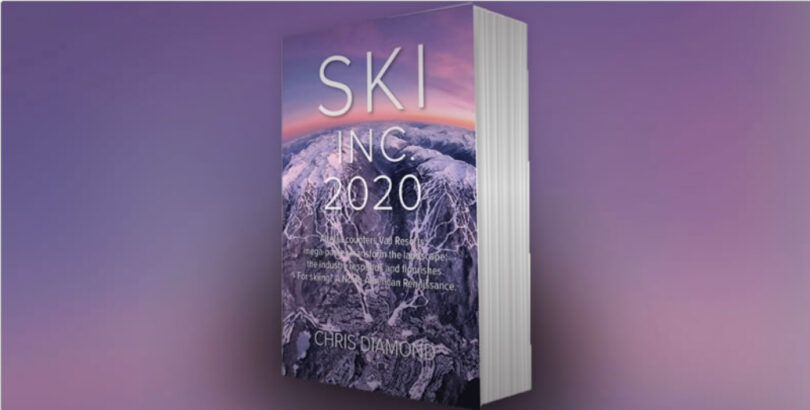Jason Blevins, The Colorado Sun
The early proofs of the book were printed and arriving for review when the story changed, yet again.
It was not the first time—and it won’t be the last—that Chris Diamond hustled to recraft his in-depth study of the ever-shifting ski resort industry.
After a hectic revision in late July, Diamond’s “Ski Inc. 2020” included Vail Resorts acquisition of 17 small resorts in the Midwest and New England. And so, so much more.
Following his insightful “Ski Inc.” in 2017, the longtime resort veteran and former boss at Steamboat ski area has updated his analysis of the resort landscape to reflect the monumental shifts in the last two-and-a-half years.
“Ski Inc. 2020,” ($29.95, Ski Diamond Publishing) includes the swift emergence of Alterra Mountain Co. and its transformational impact on the industry. The resort-shaping competition between Vail Resorts and Alterra. Vail’s purchase of Peak Resorts. The vibrancy of the mini-major operators Boyne and Powdr. The strength of independents like Taos, Sun Valley, Alta, Sierra-at-Tahoe and Sugarbush. The threat—and galvanizing force—of climate change. The critical importance of mountain communities to the health of the industry.
It’s a whole different ski world than it was in 2017.
“So why did I decide to write this book? The industry as we have known it no longer exists,” Diamond says in the intro to the book he wrote with ski media veteran Andy Bigford, the former editor of SKI magazine and Active Interest Media executive.
Back in 2017, Diamond’s decades of experience captaining major resorts led him to speculate that the withered Intrawest’s pieces would be more valuable than the whole and its resorts would be picked up one-by-one. Months after “Ski Inc.” rolled off the presses, the owners of Aspen Skiing’s Co.—Chicago’s Crown family—joined Denver private equity firm KSL Capital Partners to buy all of Intrawest and assemble what would become Alterra Mountain Co., a $1.7 billion deal that in a blink roused a competitor to the once unchallenged dominance of Vail Resorts.
Since then the two companies have been on a tear, dividing North America’s resort world into two distinct camps under the banner of their Epic and Ikon passes. The two companies are plowing record sums into resorts, improving the ski experience with new lifts and terrain, better snowmaking and on-mountain amenities. Where industry titans once clashed in base-area villages, erecting billion-dollar villages and selling condos, the battlefield has returned to the ski hill, where the arms race involves ever-swelling stables of resorts serviced by ever-swifter chairlifts and all accessed by discounted season passes. The investment has opened lending opportunities and financial markets for smaller resort operators who are able to direct more dollars into improvements.
And everyone is doing well. The skiers are getting season passes to dozens of resorts for around $1,000. And resorts are thriving, with operating profits as a percentage of revenue—or EBITDA margins—reaching record levels.
“More than a handful of CEOs are dubbing it the ‘Golden Age,’” writes Diamond, who is more inclined to hang that headline over the 1960s and 1970s, when hundreds of new resorts fed an insatiable appetite for skiing. “It’s not just the big guys who are finding success. It’s a broad, deep, transformation of an old business model that has many prospering. ‘Renaissance’ might be a better word.”
The ski resort industry loves its villains. It’s sort of a pastime for skiers and mountain locals to demonize the big bosses. But Diamond doesn’t play that way. He heaps praise on every major player, casting them all in the best of light. Especially Vail Resorts chief Rob Katz, who Diamond credits, as he should, with the company’s stellar, game-changing performance in the last decade.
Diamond’s gentlemanly approach opens doors through which few have passed. He’s got Katz admitting to laboring on his public speaking skills. He gets family-owned Boyne Resort’s Stephen Kircher expounding on the decision to align with Alterra. And perhaps most impressively, he gets John Cumming, the media-shy owner behind Powdr, talking about his decidedly un-Katz-like approach to growing his experience-based outdoor empire.
Diamond and Bigford’s institutional knowledge and their grasp of skiing history, combined with unprecedented access, deliver big insights in “Ski Inc. 2020.” The insider glimpses are as bountiful as February snowflakes in Steamboat.
Like why did the Crown family invest in Alterra but not include their Aspen Skiing Co. hills in the company’s portfolio? Did Vail Resorts really want Crested Butte Mountain Resort when it acquired the Triple Peaks quiver that included the coveted Okemo in Vermont and Sunapee in New Hampshire? Who really is the wealthiest resort owner in skiing? What operators are leading the industry in the fight to thwart climate change? The irony of people fretting the lack of participation in skiing while simultaneously bemoaning crowds lured by new, pass-driven pricing models. How ski communities are driving state economies and bolstering resort revenues and how the high country affordable housing crisis threatens those economic engines.
These are issues that rarely get addressed at a macro level and that’s where Diamond and Bigford win with “Ski Inc. 2020.” Resort operators as well as leaders and locals in mountain communities are too often buried in their own scenes, heads-down as they grapple with the challenges of life, business and skiing in the mountains, to notice that just about everyone in ski country shares similar challenges. It’s become especially hard to get that 30,000-foot perspective as the industry roils with change.
That’s where “Ski Inc. 2020” moves beyond a historical accounting of industry shifts and into the rare chance for skiers — as in everyone who skis, whether as an operator, a local or a visitor — to unite in both celebration and stewardship of a critical pastime that shapes landscapes, communities and lives.








